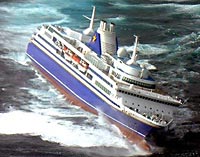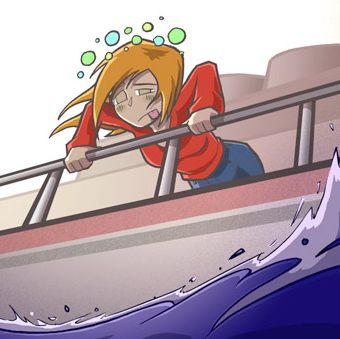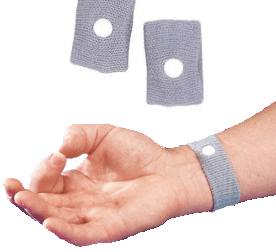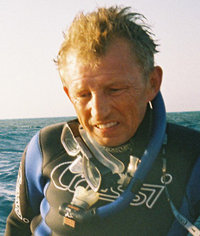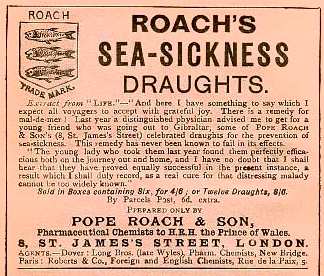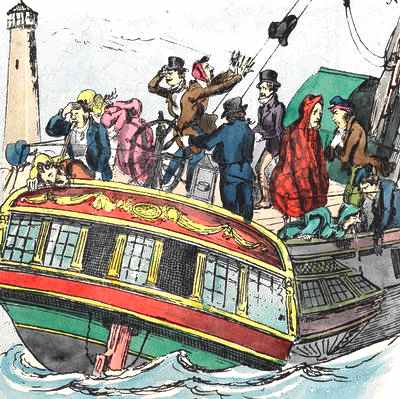|
||
|
Seasickness is a feeling of nausea and, in extreme cases, vertigo experienced after spending time on a craft on water. It is typically brought on by the rocking motion of the craft, but people who are particularly vulnerable to the condition can feel seasick simply by setting foot on a boat, even if the vessel is in dry dock, having become conditioned.
As a youngster, I was susceptible to car sickness, then as I traveled with my parents I discovered new depths of misery, with sea sickness and then air sickness. The two most severe bouts of sea sickness I can remember, were on ferries. Once crossing St George's Channel, from Fishguard to Rosslare in a force 9 and the other crossing the Bay of Biscay from Plymouth to Santander - which took days to recover from. On a trip to Venice, I first discovered air sickness, would you believe on take off from Gatwick.
Cruising the Mediterranean on the Uganda, a cruise ship operated by the British India company, was not so bad, except when visiting port, when dry land felt more unsteady than the boat. All these experiences were as a teenager. After I learned to drive, the car sickness disappeared. Which proves that if you are concentrating, you are safer. Gradually, I overcame my air sickness, on a trip to Canada in my thirties. As a diver, I discovered certain types of boat were conducive to nausea, especially round bilge smelly old diesel monohulls. Multihulls are not bad due to the short sharp motions.
I still suffer travel sickness at odd times. The last time was in a glider, which I believe was a result of hayfever, a very hot cockpit and a large greasy breakfast. I still enjoyed the experience and came back to normal on landing, within minutes.
Nelson Kruschandl - Sufferer
Naturally, I am interested in the subject, since I will be the captain of Solar Navigator for at least one big adventure. With that in mind I have researched the subject and here review the advice given on various websites, which, you can see for yourself is pretty much consistent, and really there is nothing much astounding or original by any contributor. The advice though is worth comparing, to get a feel for the subject. There are two very good websites dedicated to the seasickness, which, I have linked to at the foot of this page. If you'd like a link to your seasickness site, please email me.
Seasickness can be a debilitating condition and it is extremely dangerous if the sufferer has an important role to carry out, such as steering a yacht through stormy seas while avoiding rocks and other hazards. It is also particularly hazardous for scuba divers who, through dehydration following vomiting, are at increased risk of decompression illness. This I can confirm, as one day I was diving in a force 8 in open water and managed to get seasick while swimming. I was about 25 at the time, and in training at Fort Bovisand, Plymouth.
PLAIN SPEAKING
Seasickness is a balance problem generally attributed to overactive nerve fibers in the inner ear. Your senses provide ambiguous information to the brain as the nerve fibers attempt to compensate for the unfamiliar motion you experience as a ship moves through water. This condition often disappears on its own in a few days, once you get your "sea legs," but by that time you've seen a great deal of your bathroom and are ready to leave the ship at any cost. You needn't suffer though, there are a number of remedies available to help desensitize those overactive nerve fibers.
Motion sickness is a conflict between your senses. A fluid filled canal in your inner ear that controls your sense of balance tells your brain that your body is moving, while your eyes, looking into the cabin of the boat, tells your brain that you are not moving. That conflict can cause your body to be out of balance, and we know how the digestive system feels about that.
Early signs are: paleness, salivating, yawning, sweating and a general feeling of discomfort and not feeling well (malaise).
CAUSES
Human beings instinctively seek to remain upright by keeping their centre of gravity over their feet. The most important way this is achieved is by visual reference to surrounding objects, such as the horizon. Seasickness often results from the visual confusion on a moving craft, when nearby objects move with the motion of the craft. Because the lines of the masts, windows, and furniture on a ship are constantly shifting with respect to fixed references, humans can suffer a number of afflictions, especially those unaccustomed to being at sea.
Sea-sickness has such a remarkable effect because both the sense of sight and touch are disturbed by the motion of a craft on water. The severity of seasickness is also influenced by the irregular pressure of the bowels against the diaphragm as they shift with the rising and falling of the ship.
Many experience similar effects while not at sea:
Cruiser rolling in heavy seas
EFFECTS
Motion sickness, waves of nausea and vomiting experienced by some people, resulting from the sudden changes in movement of a vehicle. The ailment is known generally as seasickness, car sickness, train sickness, airsickness, and swing sickness. The principal cause of the disturbance is the effect of motion on the semicircular canals of the inner ear, although other factors such as inadequate ventilation and fumes or noxious odors may contribute. Drugs are available that, when taken in good time beforehand, prevent the occurrence of motion sickness.
MEDICAL EXPLANATION
Motion sickness relates to our sense of balance and equilibrium. Researchers in space and aeronautical medicine call this sense spatial orientation, because it tells the brain where the body is in space - what direction it is pointing, what direction it is moving, and if it is turning or standing still.
Our sense of balance is regulated by a complex interaction of the following parts of the nervous system :
The symptoms of motion sickness appear when the central nervous system receives conflicting messages from the other four systems -- the inner ear, eyes, skin pressure receptors, and the muscle and joint sensory receptors.
PREVENTION and REMEDY
Over-the-counter and prescription medications are readily available. Some sufferers find that wearing special wristbands also helps stave off the condition. Those suffering from seasickness who are unaccustomed to the motion of a ship often find relief by
Unlike with a hangover, succumbing to nausea normally does not relieve the symptoms of seasickness, and, once started, is often difficult to stop.
Get into fresh air and look at the horizon
MOTION SICKNESS TECHNICAL
Motion sickness is a condition in which the endolymph (the fluid found in the semicircular canals of the inner ears) becomes 'stirred up', causing confusion between the difference between apparent perceived movement (none or very little), and actual movement. Depending on the cause, it is also referred to as sea-sickness, car-sickness, air-sickness, or space-sickness.
Nausea is the most common symptom of motion sickness; in fact, nausea in Greek means seasickness (naus=ship). If the motion causing nausea is not resolved, the sufferer will frequently vomit within twenty minutes. Unlike ordinary sickness, vomiting in motion sickness tends not to relieve the nausea.
Motion sickness on the sea can result from being in the berth of a rolling boat without being able to see the horizon. Sudden jerky movements tend to be worse for provoking motion sickness than slower smooth ones, because they disrupt the fluid balance more. A 'corkscrewing' boat will upset more people than one that is gliding smoothly across the oncoming waves, and cars driving rapidly around winding roads or up and down a series of hills. Looking down into your lap to consult a map or attempting to read a book while a passenger in a car is another cause of motion sickness.
Many 'cures' and preventatives for motion sickness have been proposed at various times. One which is both practical and effective is to simply look out of the window of the moving vehicle and to gaze into the distance towards the horizon in the direction in which you are moving. This helps to re-orient your inner sense of balance by reaffirming to your inner ear that you actually are moving. Fresh air blowing on your face can also be a relief. There is also a proprietary device called Sea Band[1] which claims to work by depressing accupressure points in the wrist using a plastic stud embedded in tan elastic bracelet. This device is available without a prescription, and its efficacy has been demonstrated in clinical trials for nausea of various sources including motion sickness, pregnancy, and chemotherapy.
Anti seasick wristband
Other treatments for motion sickness rely on medication. Over-the-counter and prescription medications are readily available, such as dramamine. Ginger is a mild anti-emetic and sucking on crystalised ginger or sipping ginger tea can help to relieve the nausea.
Interestingly, many pharmacological treatments which are effective for nausea and vomiting in some medical conditions may not be effective for motion sickness. For example, metoclopramide and prochlorperazine, although widely used, are ineffective for motion-sickness prevention and treatment. The sedating anti-histamine medications such as promethazine, work quite well for motion sickness, although they can cause significant drowsiness.
Half the astronauts in the U.S. space program have suffered from space sickness, including Sen. Jake Garn, who made it his study project while a passenger on the space shuttle in 1985. The specially-designed space shuttle zero-gravity toilet has two settings: one for ordinary waste and another for vomit.
MOTION SICKNESS CAUSES
Motion sickness occurs when the body is subjected to accelerations of movement in different directions or under conditions where visual contact with the actual outside horizon is lost. The balance center of the inner ear then sends information to the brain that conflicts with the visual clues of apparently standing still in the interior cabin of a ship or airplane.
Symptoms generally consist of dizziness, fatigue, and nausea which may progress to vomiting. From one third to one half of airline passengers will experience some degree of motion sickness when encountering heavy turbulance, and it has been found that fear or anxiety can promote symptoms. Some individuals seem to be naturally prone to motion sickness since childhood.
Prevention is best accomplished by seeking areas of lesser movement in an interior location of a large ship or by facing forward and looking outside a ship or plane. Several medications are now available both by prescription and over the counter that may prevent or limit the symptoms of motion sickness. If medications are necessary, they are best taken at least one hour before embarking.
The over-the-counter medications Dramamine or Bonine can be very effective for short trips or when symptoms occurr intermittently. For longer trips, a prescription medication called Transderm-Scop comes in the form of a patch can be worn behind the ear for up to three days at a time. Side effects of these medications usually consist of sedation and dry mouth and they should not be taken by people who have glaucoma or urinary obstruction. Recent studies have shown that ginger root may be as effective as the other drug treatments but is associated with fewer side effects.
Seasick Diver
MAL DER MER
Mal de Mer is a rather pleasant and unassuming French term for the debilitating effect motion sickness may have on your body. Luckily, it is not usually life threatening although many sufferers wish it were if only to bring relief to the extreme discomfort they feel!
This is not a problem just for the elderly, sick or those of us that are just plain wimps. Recent research has reported that of 79 US Space Shuttle missions 94% of astronauts used some medication during flight. 47% of that medication was for the relief of space motion sickness. Hope that makes you feel a whole lot better!
One of the most irritating things about seasickness is how everyone else around you just goes on their merry way, perfectly comfortable and happy, in the same conditions that have reduced you to utter misery.
Many first time passengers will be anxious about the possible effect seasickness will have on them and the potential disruption it will have on their well earned vacation. Old hands will want to know what can be done to avoid the worst effects they may have suffered on previous boat trips.
Try not to let anything you read on this site prevent you from taking your well earned break and from enjoying what may be a thoroughly rewarding journey via sea. Rather, use it to your advantage and in all probability, for those of us it affects, seasickness will be a short term discomfort.
The movement of a boat on a fluid sea creates stress in the portions of the brain responsible for balance. Perhaps that stress causes the brain to start malfunctioning as the land based environment it understands is suddenly not behaving as it should.
The visual stimulus is misleading as it reports things like cabin walls, and furniture, in such a way that the brain interprets these things as stable when they're not. Your brain is being told by the vision system that the world is stable, while the inner ear is screaming that it's not.
The good news for sufferers is that the condition often disappears without medical treatment within a few days. As your brain learns to compensate for the swaying and pitching of the boat you will get your “sea legs”. One unfortunate aspect is that after a prolonged period at sea it may take a while for you to adjust to being on terra firma again.
Pope Roach's seasickness pills
PREVENTION
You can often avoid seasickness by staying busy and keeping your mind occupied. Any activity that will keep you above decks and focus your mind on anything other than the swaying environment will help. Staying in fresh air instead of in a stuffy cabin may help. Take deep breaths and drink plenty of water. The worst thing that you can do is go below decks with no land or horizon to look at.
Reading or staring at an object will assuredly bring on the affects of seasickness. Keep your senses, particularly your eyes, working flat out interpreting the motion of the boat and the waves.
Find a haven on the boat where the motion is at its minimum and which allows your eyes to gaze at the horizon. On a large ship try and face forward. Your peripheral vision is an important factor keep it out on the horizon but do not visually lock on to it. Let you brain adjust to this unstable environment by allowing the horizon to act as a true point of reference.
If you can, try and eat lightly and avoid fatty or spicy foods. Try to stay warm, relaxed and comfortable. Try to sleep at the appropriate time and allow your brain to recover. Spending valuable leisure time in bed isn't fun, but a prone position could alleviate some of your symptoms. If possible try not to lie down in your cabin, instead find a deck chair and get some fresh air as well.
There are certain remedies that may help some sufferers and these are discussed in the next section. Medication must be taken hours before you travel and not during the onset of symptoms. Herbal remedies such as ginger are reported to have a beneficial effect. There is some evidence in the medical papers section which supports this. Some non pharmaceutical aids such as pressure bands are claimed to help.
Try choosing the type of boat, where you sail and what season you travel carefully. Modern cruise ships are equipped with stabilizers that eliminate much of the motion responsible for seasickness. Bigger is best, if your boat is a mega-liner it may not pitch and roll quite so much as a smaller craft.
If you have a history of motion sickness do not book an inside cabin, it will begin to resemble a movable coffin!
Remember - if your eyes see what your ears are feeling, you will certainly have a better chance of avoiding the worst effects of seasickness.
13 USEFUL TIPS
1. Get plenty of rest before you go out on the water. Weariness and exhaustion can make you more susceptible to other things that can bring on motion sickness. Do your gear preparation early the day before and take care of other business well before a proper bed time.
2. Do not eat greasy or acidic foods for several hours before your sailing adventure. This includes having coffee also. You don't want to have a lot of acid or heavy, slow to digest foods rolling around in your stomach while you are rolling around on the sea. Heavy, greasy foods like bacon and eggs, sausage, waffles or pancakes with syrup, alone or combined with acidic juices like orange juice, can wreak havoc on your system and end up recycled as lunch for fishes. Consider less acidic fruits (apples, bananas, pears, grapes, melons, etc.), breads (muffins, croissants, rolls), cereals and grains as alternatives. Milk, water, apple juice, cranberry juice and other low acid beverages are gentler alternatives to orange juice or grapefruit juice.
3. Caffeinated beverages (including soft drinks) should be avoided as they are diuretics (make you urinate), which accelerates dehydration. The gas in carbonated beverages has negative responses in some, avoid them also.
4. Do not skip eating before sailing. An empty stomach can be almost as bad as one with the wrong types of food in it. Give your stomach acids something to work on other than your well-being. Give your stomach time to begin digesting you meal. Get up a little earlier if you must to eat, relax an hour or more before going out on the water. Don't overeat and get bloated either. Easy does it.
5. Drink plenty of water. Partial dehydration lowers your body's resistance to the stressful factors caused by the boat ride. Take lots of water with you and drink often.
6. Do not drink alcoholic beverages for several hours. Alcohol tends to dehydrate the body. Its other symptoms are not desirable either. Alcohol can prevent the REM (Rapid Eye Movement) stage of sleep, the one in which you dream and your brain rests. You may feel tired and unalert from just a few drinks, two qualities not conducive to safe boating. If you do plan on drinking, make every third drink a glass of water. It will reduce dehydration and your chances for a hangover.
7. Avoid gasoline or diesel fumes. They can put you over the edge literally and figuratively. Stay out of direct sunlight as much as possible. Avoid becoming overheated and dehydrated.
8. Again, if possible, avoid the cabin and other enclosed spaces. Sometimes, a breezy spot in the sun may be preferable to a shady spot in a stuffy cabin. The open air and ability to look out over the horizon are often more important than being in a shady spot, which can be stuffy and enclosed, limiting your view of the horizon and perhaps making you more prone to motion sickness.
9. There will be less motion towards the center of the boat, both horizontally and vertically, and it will increase with the height of the waves. Avoid the upper decks as the higher you go, the more you will experience swaying back and forth. Horizontally, you want to be amidships, towards the center, rather that at the bow or stern. The more sensitive to motion sickness you are, the closer you need to be towards the center, which is the calmest part of the boat.
10. If you are beginning to feel a bit queasy, stand up and look out over the horizon. Despite what you might think, sitting or laying down is the worst thing you can do at this point. Don't do it. This is a critical moment. You will get much worse even faster and may reach a point of no return if you make the wrong choice. Soda crackers seem to help some people by calming their stomachs and reducing nausea. Steering the boat is an instant remedy.
11. When the boat is rolling with the waves rather than moving under its own power and you are standing on deck, possibly getting hot, your resistance to motion sickness diminishes rapidly. Reduce that exposure time to an absolute minimum. 12. Have some water and fruit before. It can help by rehydrating you.
13. If someone in your party is overcome by sea sickness, get away from them at once! Unfortunately, many of us can do fine until someone else loses it. Then we have a sympathetic reaction and succumb as well. It could be the sound, the smell, the sight, or a combination of them that triggers the same response in us. You don't have to be close to your buddy at this time. There is nothing you can do to help. If you feel nauseous and about to succumb, please avoid the entry and exit areas of the boat. Hang your head over the gunwales
Cartoon from 1825 depicting ferry outing
MEDICATIONS
Even seasoned sailors who "don't get seasick" have been known to resort to medications on occasion. The most common drugs are Dramamine, Dramamine II, and Bonine. These proprietary brands are essentially anti-histamines and are available at most pharmacies over-the-counter. The side effects of anti-histamines are to make most people drowsy. Dramamine will almost certainly have that effect. Dramamine II and Bonine are formulated to be non-drowsy, but they still put some people to sleep. Considering the alternative, that's not such a bad thing.
If you want to beat mal de mer before it has the chance to sneak up on you, it's recommended that you take one of these remedies a couple hours before sailing. If you don't bring your own, there is sure to be a good supply onboard in the sick bay or at the Purser's Desk.
THE PATCH
Worn behind the ear, the "patch" dispenses a continuous metered dose of medication that's absorbed into the skin and enters the bloodstream. Apply the patch four hours before sailing and it will continue to be effective for three days. You'll need a prescription from your physician for the patch and, while wearing it, be vigilant for possible side effects including blurred vision, dry mouth, and drowsiness. Additionally, alcohol should be avoided and you shouldn't drive or do other things that require alertness until you discontinue using the patch.
OTHER SUGGESTIONS
No one wants to be drugged up and drowsy when they should be enjoying a cruise. There are nearly as many remedies for seasickness as there are sufferers, so why not explore a few natural cures.
Bitters: If you are a drinker, have the bartender mix up a couple tablespoons of Angostura Bitters in a half glass of water or club soda. Do this right away and you probably won't need the rest of these remedies.
Sea-Bands: These wristbands work on the principle of acupressure. Each elastic Sea-Band has a round button on the inside and when positioned to press a particular point on the inside of the wrist, the nausea associated with seasickness disappears. They are sold in many pharmacies, luggage stores, and even some travel agencies. Many ships' sundries shops also have them but if the ship begins to rock and roll, they'll sell out in a heartbeat.
Ginger: Sometimes good for for an upset stomach and it can't hurt if you can keep it down. Ginger capsules and crystallized ginger, available in health food stores and supermarkets, are supposedly even more effective.
Food: You won't feel like it, but you should try to eat something. Crackers, broth, and ginger ale might help and do for me. Some people recommend crackers and apples for those who can't keep liquids down. The apples replace vital body fluids, but also introduce acid.
Lying Down: Spending valuable cruise time in bed isn't fun, but a prone position should alleviate some of your symptoms. But, don't lie down in your cabin, instead find a deck chair and get some fresh air at the same time.
Fresh Air: If nothing else, fresh sea air smells good and is bound to improve your mood, unless it's very cold. Keeping an eye on the horizon can also help restore your sense of balance. If you are on a small smelly round bilge diesel, I wouldn't rate your chances.
Some insensitive people (usually family) will tell you seasickness is "all in your head." Of course, in a way it is. It's that inner ear thing and a very real problem for many unfortunate passengers. The last thing you need is to be told you're weak in the head, when you're trying to focus. However, if you're determined to enjoy a vacation at sea, it won't hurt to give these methods a try.
ONE POSSIBLE RELIEF by CAPTAIN MIKE MAURICE
This information is provided to you, for free, by Captain Mike Maurice's Yacht Delivery Service. He has made an effort to make his site the best, most interesting Seasickness web site in the world! During the course of 35 years making many deliveries up and down the US West Coast and other places, he slowly found the tricks to use, to prevent people from becoming sick and to cure those already so.
The popular press articles and books and the instructions included with the commonly used medications are incorrect and if followed will result in many people needlessly becoming seasick. In most cases they do not have a way to cure those who have become seasick. Captain Maurice's method does not involve anything which requires a prescription and can be used on very young children as well as the elderly, with a few precautions.
In summary, chewable Dramamine or Meclizine, if chewed but not swallowed and then dissolved in the mouth, will be absorbed into the lining of the mouth and thence into the blood stream. It would appear from some reports that I have received that some Pharmacists and even some Medical Doctors have been telling people that Dramamine or Meclizine will not be absorbed in the mouth. See this link for reference to a clinical study which proves this is not so. Unless the medication makes it into the bloodstream there will be no effect. Pills swallowed, will often not get into the blood, because they never get out of the stomach and into the small intestine, where they can be absorbed. This technique will effect a cure in most victims.
The other mistake in the literature is that it takes 2 full hours for the medication to reach maximum effectiveness, 1/2 hour or an hour as often suggested, will often not work. See the link above about the "clinical study" for details about the amount of time required. The study demonstrates that maximum effect occurs in 2.3 to 2.6 hours.
Detailed explanation, dosages, sources of medication and methods for adults and children are on subsequent pages. This information is offered to you FREE of charge, use it at your own discretion. Many have found it to be a very effective.
Here are links to other web sites, these sites include those of drug and device manufactures and recommended information sites.
Medications,
Dosages and Comments DRAMAMINE, MECLIZINE by CAPTAIN MIKE MAURICE
The following couple of paragraphs are basically about DImenhydrinate (Dramamine) or Meclizine. They are the only things Captain Maurice recommends for normal seasickness curing and prevention. I would not use any other drugs, unless these two fail to work. See the table of Trade Names.
Contrary to the literature in boating magazines, some prepared by doctors, or the literature included with the medications, it takes 2 hours for these things to reach maximum effectiveness. This means that if you are getting sick and you did not take the stuff 2 hours before, it is liable not to work. Most of us, me included do not like taking medications, unless really needed. Consequently, most people don't take the medications 2 hours before, but only 20 minutes to an hour ahead of rough water. The medication fails to work and the victim is convinced that medications don't work. Mikes Opinionated Opinions.
One more thing about medications. There is an illusion that all of these drugs will make you drowsy. It may be true that one or another will make any one individual drowsy. The solution is to try the various ones till you find one that doesn't. Now get this. It is my experienced opinion that most of these drugs do not make anyone drowsy. It is an illusion. You start to get sick, you take the drug, it doesn't work (not enough time), you get drowsy from the effects of being seasick. Don't blame it on the drug.
Now here comes the punch line. The prevention of seasickness is mostly a matter of medication. The method of introduction into the bloodstream is the tricky part. Scopolamine patches work by direct introduction into the blood vessels behind the ear. With Dimenhydrinate or Meclizine (chewables), effects are immediate (less than 3 minutes). Medications taken by mouth may be held up in the stomach and never reach the digestive tract (to be absorbed into the blood), if one is already a little seasick. It may be that many victims have the pyloric valve already closed, and are a "little" seasick before they ever step aboard.
Dramamine is available in a chewable tablet, so is meclizine (both are over-the-counter drugs.) Dramamine has been tested on children as young as 2. I have used on both of these on children. The trick to using these things, is not to swallow the drug, but let it dissolve in the mouth. Be warned, meclizine chewable is hard1 on the lining of the mouth. It should be chewed up very fine and not allowed to stay long, in any one place. Swallowing some of this is ok. Frankly I have taken to not even chewing it, just suck on it until it dissolves.
Chewable Dramamine is not as hard on the lining and I prefer it for children, but it is more expensive. The chewed tablet will absorb best in the cheek, but you can hold it under the tongue. For a story of a recent cure for one very sick crew member click here.
MIKE'S TIPS and DETAILS on DOSAGES
In general follow the directions included with the pills. With the exception of the suggestions I have given you here in this material, also see detailed dosages and notes.
The effects of these chewable drugs is almost instantaneous (30 seconds?), and improves with time. In the case of adults who are already sick, it may take 1 1/2 Dramamine tablets to get them stabilized (a little over-dosing is generally ok, if not continued.) Meclizine chewable is now my favored medication for almost everyone. The 25mg tablets are very effective, children included(1/2 tablet) and generally last many hours longer than Dramamine. Rarely do we have to do this more than once more unless rough water comes along.
By the way, I claim no experience with "motion sickness" per se. General motion sickness is very much the same as "seasicknes", but there may well be differences. And the only thing I have experiemented with is seasickness. So, keep that in mind.
1 "Hard on the lining", means the material tends to make the lining of the mouth sore. Even to the point of causing sores which heal over in a couple of days.
Captain Maurice is interested in feedback using a pre-setup email form.
Contact Mike: e-mail address "mikem@yachtsdelivered.com"
Sea-Sickness
By CDR John Masefield
I must go down to the wharf again,
to the lonely wharf and the sky;
I must go down to the wharf again,
for the call of the Janitor Squad
I
must go down to the wharf again, to our rotted out hulk of a ship,
WILL YOU GET SEASICK
Until you try sailing, there's no way to tell. If the very thought of boarding a floating object makes you green around the gills, you probably will get seasick. If you have a problem with motion sickness in automobiles and airplanes, you are more than likely to suffer. It is also true that if you get nauseous in a smallish boat, that doesn't necessarily mean you'll get seasick on a cruise ship. It's all a question of degree.
Many modern cruise ships are equipped with stabilizers that are supposed to eliminate the motion responsible for seasickness. My experience is that they don't really work in rough seas. The chances are though, that if your cruise does not include the Atlantic or Pacific blue water routes, you may not even feel the ship's movement, particularly if your ship is one of the larger liners such as the QE2 or Oriana doing the Mediterranean circuits.
For first time passengers concerned with seasickness, a large liner is the ship of choice. They are very stable in calm seas due to the speed length ratios ironing out the waves. So, where are you likely to find a cruise on a decent size liner in calm seas? Well, the Caribbean is an obvious destination in winter and spring. You may want to avoid the height of hurricane season (Katrina, etc) when tropical storms can turn any voyage into one of abject misery, from late August until November.
If you already suffer motion sickness in cars, etc, don't book an inside cabin. For the terminally seasick, it as a recipe for calamity. As you may discover from the above ramblings of many different contributors, all coming to the same conclusion as myself. Being able to view the horizon is very important.
One study suggested that 14% of the population gets seasick, but this is a fairly meaningless number unless related to sea state. In an extremely rough sea, way more than 14% of passengers will get sick. And it shouldn't be taken as a sign of weakness if you get motion sick. Seventy percent (70%) of space shuttle crew members experience some degree of motion sickness during the first 3 days of any shuttle flight.
You'll even find that many crew on ships occasionally get sick too. Babies under the age of about two seem immune from seasickness. Children are more susceptible than adults, and the older you get, the more resistant you appear to become.
The type of motion also has an impact. The most seasick causing motion is one with about a five second cycle of repetition. This might be why some people get sick on big ships (with about a 5 second cycle of moving from one side to the other and back) but not on small boats (which move with much quicker motion periods.
Women seem to be more susceptible to seasickness than men. People of oriental race seem more susceptible than westerners.
No benefit to health - wish I'd stayed in Putney
MOTION SICKNESS LINKS:
Cause
of motion sickness
A comparison of the efficacy of cinnarizine with scopolamine in treating seasickness Antimotion-sickness efficacy of scopolamine 12 and 72 hours after transdermal admin Cinnarizine in the prophylaxis of seasickness: laboratory vestibular evaluation and study Comparison of Seven Commonly Used Agents for Prophylaxis of Seasickness Computerized dynamic posturography and seasickness susceptibility Contributions of roll and pitch to sea sickness Double-blind comp transdermal scopolamine droperidol & placebo postop nausea/vomit Treatment of motion sickness: scopolamine alone/combined ephedrine real & simulated Effect of cinnarizine in the prevention of seasickness Effect anti-motion-sickness medication cinnarizine on central nerv syst oxygen toxicity Effect of transdermally administered scopolamine in preventing motion sickness Effects of gender of subjects and experimenter on susceptibility to motion sickness Effects of ginger on motion sickness susceptibility and gastric function Effects of N-methyl-D-aspartate antagonists on different measures motion sick in cats Efficacy of transdermal scopolamine against seasickness: a 3-day study at sea Gastrointestinal motor and myoelectric correlates of motion sickness Ginger root against seasickness. A controlled trial on the open sea Ginger: history and use Illusory self-motion and motion sickness: a model for brain-gut interactions and nausea. Influence of transdermal scopolamine on motion sickness 7 days' expose heavy seas INM investigations into drugs for seasickness prophylaxis Motion sickness amelioration induced by prism spectacles Motion sickness susceptibility questionnaire revised & relationship other forms sickness Motion sickness. How to help your patients avoid travel travail Perspectives of electrogastrography and motion sickness Pharmaceutical use by U.S. astronauts on space shuttle missions. Pharmacologic studies of antimotion sickness actions of ginger Physiological basis and pharmacology of motion sickness: an update Postural instability precedes motion sickness. Prevention of motion sickness with a transdermal therapeutic system containing scopolamine. A randomized, comparative double-blind study in the German Federal Navy Prophylactic ondansetron for post-operative emesis: meta-analysis of its effectiveness in patients with and without a previous history of motion sickness. Relationship between motion sickness, migraine and menstruation in yacht race crew Relationship between postural control and motion sickness in healthy subjectsSalivary changes associated with seasickness Salivary secretion and seasickness susceptibility Scopolamine alone/comb ephedrine in seasickness: double-blind placebo-control study Seasickness treatment with cinnarizine Self-induced motion sickness in unperturbed stance Slow deep breathing prevents development tachygastria & symptoms motion sickness Systematic investigation of physiological correlates of motion sickness induced by viewing an optokinetic rotating drum. Anti-motion sickness mechanism of ginger comparative study placebo dimenhydrinate. The retention of adaptation to motion sickness eliciting stimulation These vestibular problems in the absence of gravity Three-years' experience of transdermal scopolamine long-term effect & side-effects Transdermal scopolamine in the prevention of motion sickness at sea Transdermal scopolamine in prevention motion sickness evaluation time course efficacy Transdermal therapeutic system scopolamine (TTS-S) prevention sea sickness mech Transdermal therapy syst scopolamine (TTSS) dimenhydrinate placebo study at sea Transdermally administered scopolamine vs. dimenhydrinate effect on nausea Variables movement amplitude & frequency development motion sick Suncus murinus Visual-vestibular habituation and balance training for motion sickness
FREIGHTER TRANSPORT LINKS:
A la Carte Freighter Travel - See the types of freighters are available how to book. Around the World by Freighter - See if you're suited for this style of sea travel. Cruise & Freighter Travel Association - Helped freight sailors since 1967. Cruise People, Ltd. - Offers freighter voyages between 7 - 120 days. FreighterTrips.com - Online resource for planning a freighter cruise Freighter World Cruises, Inc. - Travel agency for freighter travel around the world.
CRUISE TRAVEL LINKS:
American
Cruise Lines
Solar Cola - the healthier alternative
|
||
|

